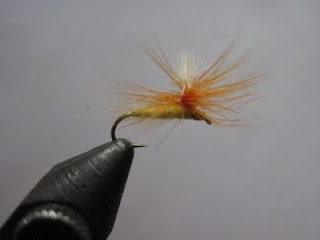
I fish only with about half a dozen dry fly patterns. That's it. For the next couple weeks I will talk about them, and discuss the reasons I think they work and why I like them.
The first is Bob Smock's version of the sulfur dun. The sulfur dun is my absolute favorite hatch because they go off in May, on long afternoons. None of this 15 minutes before dark crap, they hatch all afternoon, and have the decency to wait until after lunch. It is the first fishing of the year that doesn't lead to snow that puts you back in the bar by 4:00 pm with hot drinks to ward off hypothermia. The scientific name is Ephemerella dorothea, and there are dozens of patterns. Most authors talk about matching body color to the dun found in local streams, and they do vary a lot, from a bright yellow to some hot orange ones I saw on the Rapidan River once in VA. Sulphurs, aside from their angler friendly hatching schedule must be very tasty to trout. When they appear, trout start feeding right away. None of this bugs on the water but no rises crap you get with the Hendricksons.
Bob Smock was a tyer from Grayling Michigan, and was known for making shadow boxes of classic Ausable River patterns. He passed away recently, but his son carries on the tradition and builds elegant Ausable River boats. Fish from one before you die.
The pattern uses tangerine hackle. You can't buy it, and have to make it yourself using Rit tangerine dye. Before you write this off as rantings of a crackpot, listen.
I was fishing with Todd Fuller, who guides clients on the North Branch of the Ausable up by Lovells. We were, of course, catching fish. I love fishing with Todd because he puts up with a lot of flies in his hat, my deliberate choice of the wrong rod, and my frequent missed hooksets. Brook trout were rising so frequently that even I was catching them, and I was using the Smock sulfur. We were drifting, and it was a hit about every minute, or faster. For some reason, I decided to change flies and pulled out an ersatz Smock sulfur that I had picked up at a local shop in Grayling. Kept fishing. Deadsville. Todd then stated, "Jeff, you have not had a fish rise in 10 minutes. You need to change flies". I impudently told him that I was using the correct pattern. His reply: "no I think you need a true Smock sulfer. The one you are using is the wrong color". I looked, and it was true. My store-bought hellion was a bright lurid orange, the sopping one drying on my vest was tangerine. Todd tied one of his on for me, and there was a rise on the first cast. My wife witnessed this, and swears it is true.
I took some to Pennsylvania, and the browns at Fisherman's paradise hit it so madly that I think the other guys thought we were using bait. That is a place where there is intense fishing pressure, but nearly every riser came up for them.
At this point, you have probably skipped to the recipe. My friend Paul C. posted it for me, and he got it right from Bob Smock. Glug a couple of ounces of vinegar into a pot, and add a quart of hot water. Not boiling, but hotter than from the tap. Paul likes 140 F. Stir in the dye packet, drop in a white neck or saddle, and let it soak for 20 minutes. Do not panic when it starts looking almost brown. You want a dirty orange. The fly uses tangerine fibers for the tail, a yellow poly dubbed body, and tangerine hackle. I tie them parachute style with a white post, but you could probably tie them in a traditional style if you wanted.
I have no idea why this pattern works with tangerine hackle. Maybe it is supernormal stimulus like a maraschino cherry. Maybe they view it as three or four duns all tangled together. Maybe it is more visible. But this is one case where I don't care.
I know of only a couple orange dry fly patterns. Gary LaFontaine had one called the flamethrower that used flourescent orange and cree hackle wound together in a variant style, a cream body, and an orange tail. There are also one or two weird orange ones in George Leonard Herter's book "Professional fly tying, spinning, and tackle making manual". I think one was called the fish hawk and it was just an orange floss body with a badger hackle. I tied some as a kid and they never worked. And LaFontaine himself did not write about the flamethrower with the same enthusiasm he described most of his other patterns. So orange is just not a color for dry flies. Without any history, how did Bob Smock figure it out so perfectly? I wish I had known him.
